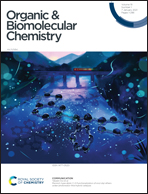Glycosyl disulfides: importance, synthesis and application to chemical and biological systems
Abstract
The disulfide bond plays an important role in the formation and stabilisation of higher order structures of peptides and proteins, while in recent years interest in this functional group has been extended to carbohydrate chemistry. Rarely found in nature, glycosyl disulfides have attracted significant attention as glycomimetics, with wide biological applications including lectin binding, as key components of dynamic libraries to study carbohydrate structures, the study of metabolic and enzymatic studies, and even as potential drug molecules. This interest has been accompanied and fuelled by the continuous development of new methods to construct the disulfide bond at the anomeric centre. Glycosyl disulfides have also been exploited as versatile intermediates in carbohydrate synthesis, particularly as glycosyl donors. This review focuses on the importance of the disulfide bond in glycobiology and in chemistry, evaluating the different methods available to synthesise glycosyl disulfides. Furthermore, we review the role of glycosyl disulfides as intermediates and/or glycosyl donors for the synthesis of neoglycoproteins and oligosaccharides, before finally considering examples of how this important class of carbohydrates have made an impact in biological and therapeutic contexts.

- This article is part of the themed collection: Chemical Biology in OBC


 Please wait while we load your content...
Please wait while we load your content...